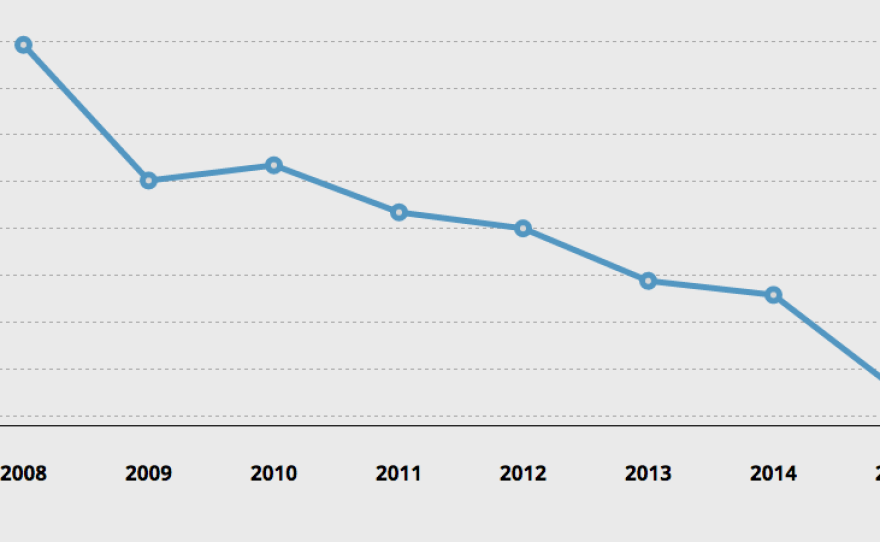This is KPBS Midday Edition this is Maureen Cavanaugh the National Runaway Safeline is there for teens to turn for help when I want to run away their online on the phone they can get advice cousin a message no more have someone listen to their problem. The safe line compiles a great deal of information from interactions in the organization is out with its annual rate or on youth in crisis. Earlier today I spoke with Maureen Blaha executive director of the National Runaway Safeline. Mooring welcome to the program. I'm happy to be here. Thank you. Behavior report the kids contacting the safe line of are getting younger and reports of abuse are increasing can you tell us about that? What was striking about the most recent report is that there was a huge jump in 13-year-olds that were connecting with the National Runaway Safeline, a 44% increase from 2014 to 2015. We believe that a lot of that is related to more and more young people connecting to us digitally. So going on to our website, doing live chat, sending emails, posting things on the forum, it seems that the younger teens are more comfortable, at least initially, connecting to us that way. Although it is alarming to think that there was a 44% increase in 13-year-olds connecting with us, most of them are connecting with us because they are thinking of running and they are not away from home. That is a safer way for us to provide support for them. They are in a safer place typically. Also there was a boosting the number of kids reporting abuse and the largest increase was verbal abuse is that right? Yes in both emotional and verbal abuse. What we noticed was from 2014 to 2015 there was a 21% increase but actually over the past 10 years there was a 30% increase in those connecting with us and really indicating that the primary reason was because of verbal or emotional abuse that is going on in the home. So it was either the reason that they ran from home or the reason that they are thinking of running from home. How many calls did you get or how many contacts from San Diego last year? It was about 1100. That is really a significant number. Maureen, I want to make sure that your listeners understand that this runaway prices in our country is some that touches all geographies all socioeconomic families, all cultures, it really is a significant issue when you imagine that one .6 to 2 28 million use will run away from home this year. Monterey mention that in the report you note that calls from California have been declining since 2008, last year there was about 9500 calls from California in 2008 there were 17,000. What do you garner from that data? One of the things that might be responsible for that is there is a line that although it was handled by covenant House in New York really kids from across the country with connect to the nine line and that was 1-800-999-9999 nine and we were taking their calls for a few years and then just we were not able to do it anymore. So our overall call volume has dropped as well. Finally Maureen what are some warning signs that would indicate a young person is in the last thinking of running from home and what should a family do? There are four things I would like your listeners to understand about warning signs. One is changes in behaviors or patterns, that might mean something is going on, the child is under stress, and by that I mean oh this is a gregarious teen that is all of a sudden becoming with John, staying in their room, not eating, mood swings, the second would be any rebellious behavior. It is often the start of travel and by that I mean grades are dropping, truancy's, picking fights with family members. Third, if the parent notices any accumulation of money or possessions because to survive runaways need some to keep them alive on the street. Lastly, if ever a young person discloses that they want to run from home they just want to get out of the situation, parents need to take that very seriously, sit down with the child, talk about why the child said that and say we do not want you to leave here. We will work on this together. I have been speaking with the Maureen Blaha the executive director of the National Runaway Safeline Maureen, thank you so much. Thank you Maureen for this opportunity. The national runaway hotline number is 100 runaway -- is 100 runaway. This can be used by parents or teens.
National Runaway Safeline, a hotline for runaways and teens in crisis, said that California-based calls dropped 18 percent last year.
According to its annual report published Wednesday, the service received 9,514 calls from California in 2015. It received 57,194 calls nationwide, a 40 percent drop.
The decline is partially due to more teens contacting the service through email, chat and other online tools.
“We saw a huge jump in 13-year-olds accessing services, which leads us to believe this new generation of teenagers feel more comfortable connecting to crisis services digitally,” National Runaway Safeline spokesperson Katy Walsh said.
The top issues raised by teens calling in are family dynamics and abuse, with emotional and verbal abuse the fastest growing issue of concern, rising 50 percent over the past three years.
Maureen Blaha, National Runaway Safeline's executive director, explains more data from the report on KPBS Midday Edition Thursday.









